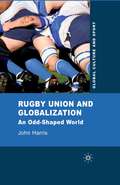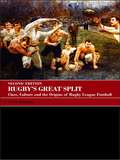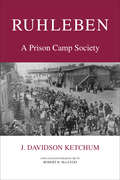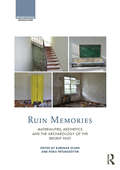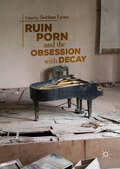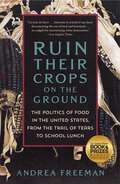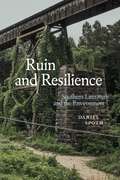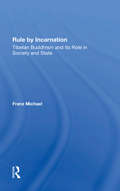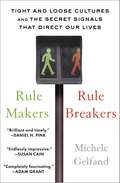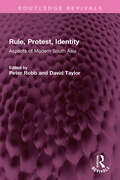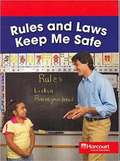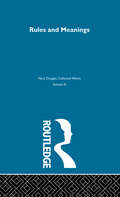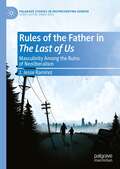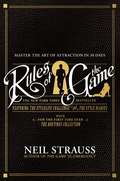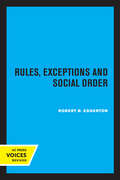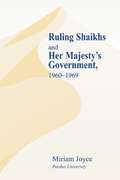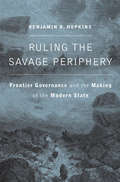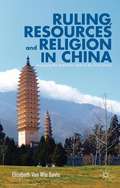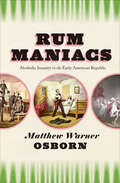- Table View
- List View
Rugby Union and Globalization: An Odd-Shaped World (Global Culture and Sport Series)
by J. HarrisIn 1995 rugby union finally became a professional sport following more than a century as an amateur game. This book offers a critical analysis of the sport in the professional era and assesses the relationship between the local and the global in contemporary rugby union.
Rugby's Great Split: Class, Culture and the Origins of Rugby League Football
by Tony CollinsSince it’s first publication, Rugby’s Great Split has established itself as a classic in the field of sport history. Drawing on an unprecedented range of sources, this deeply researched and highly readable book traces the social, cultural and economic divisions that led, in 1895, to schism in the game of rugby and the creation of rugby league, the sport of England’s northern working class. Tony Collins’ analysis challenges many of the conventional assumptions about this key event in rugby history – about class conflict, amateurism in sport, the North-South divide, violence on the pitch, the development of mass spectator sport and the rise of football. This new edition is expanded to cover parallel events in Australia and New Zealand, and to address the key question of rugby league’s failure to establish itself in Wales. Rugby’s Great Split is a benchmark text in the history of rugby, and an absorbing case study of wider issues – issues of class, gender, regional and national identity, and the impact of the commercialization and recent professionalization of rugby league. This insightful text is for anyone interested in Britain’s social history or in the emergence of modern sport, it is vital reading.
Rugby, Soccer and Irish Society: 1921-1990 (Routledge Research in Sports History)
by Conor MurrayThis book is the first academic all-island history of either rugby union or association football, two of the three most popular male sporting pastimes in Ireland, across the seven decades that followed the political partition of that country between 1920 and 1922.It moves beyond the occasionally simplistic explanations of the development of Irish sport that have focused on political and sectarian divisions, and goes deeper into the social, cultural and geographical dynamics of the island of Ireland to explain why certain people have played certain games in certain places. Drawing on historical and archival sources as well as cutting-edge geographical information systems, the book brings to life the spatial trends in each game’s administrative development and geographical distribution, that have not normally been a feature of many previous histories of Irish sport. The book also examines first-and-second-hand accounts of athletes and administrators involved in rugby and football during that period, to explore what it meant to represent a province or country at these crucial moments in Irish history and compares the Irish experience of both sports with experiences in other comparable countries.Shining important new light on the interactions between Irish rugby and football and the political, social, economic and cultural trends of Ireland in the twentieth century, this book is fascinating reading for anybody with an interest in the history of sport, Ireland or the UK.
Rugs, Guitars, and Fiddling: Intensification and the Rich Modern Lives of Traditional Arts
by Chris GoertzenWhat do exotic area rugs, handcrafted steel-string guitars, and fiddling have in common today? Many contemporary tradition bearers embrace complexity in form and content. They construct objects and performances that draw on the past and evoke nostalgia effectively but also reward close attention. In Rugs, Guitars, and Fiddling: Intensification and the Rich Modern Lives of Traditional Arts, author Chris Goertzen argues that this entails three types of change that can be grouped under an umbrella term: intensification. First, traditional creativity can be intensified through virtuosity, through doing hard things extra fluently. Second, performances can be intensified through addition, by packing increased amounts of traditional materials into the conventionally sized packages. Third, in intensification through selection, artistic impact can grow even if amount of information recedes by emphasizing compelling ideas—e.g., crafting a red and black viper poised to strike rather than a pretty duck decoy featuring more colors and contours.Rugs handwoven in southern Mexico, luthier-made guitars, and southern US fiddle styles experience parallel changes, all absorbing just enough of the complex flavors, dynamics, and rhythms of modern life to translate inherited folklore into traditions that can be widely celebrated today. New mosaics of details and skeins of nuances don’t transform craft into esoteric fine art, but rather enlist the twists and turns and endless variety of the contemporary world therapeutically, helping transform our daily chaos into parades of negotiable jigsaw puzzles. Intensification helps make crafts and traditional performances more accessible and understandable and thus more effective, bringing past and present closer together, helping folk arts continue to perform their magic today.
Ruhleben: A Prison Camp Society (Heritage)
by J. Davidson KetchumThis is an unusual book in that it is an important contribution to social psychology and also an absorbing story of four strange years in a German prison camp of World War I. Four thousand men and boys from the most varied walks of life—professors, seamen, jockeys, schoolboys, bank directors, musicians, clerks, scientists—were taken from civilian life and placed in Ruhleben on the outbreak of war; no activities were prescribed for them, no direction was given to their communal life. In the event, this miscellaneous group of people, closed off from the world, create d their own society. This book is the story of how they did it and what the society they made was like; much more than this, the camp provides a gifted and sympathetic social psychologist with a rare opportunity for study and analysis of an important if inadvertent social experiment. The time elapsed between the event itself and the completion of the book may in one way be regretted; it did, however, allow the author, who was himself and inmate of Ruhleben, the opportunity for mature reflection on its meaning. The book is a contribution to the history of World War I; it is also a basic and timeless study of the dynamics of individual and group behaviour.
Ruin Memories: Materialities, Aesthetics and the Archaeology of the Recent Past (Archaeological Orientations)
by Bjørnar Olsen Þóra PétursdóttirSince the nineteenth century, mass-production, consumerism and cycles of material replacement have accelerated; increasingly larger amounts of things are increasingly victimized rapidly and made redundant. At the same time, processes of destruction have immensely intensified, although largely overlooked when compared to the research and social significance devoted to consumption and production. The outcome is a ruin landscape of derelict factories, closed shopping malls, overgrown bunkers and redundant mining towns; a ghostly world of decaying modern debris normally omitted from academic concerns and conventional histories. The archaeology of the recent or contemporary past has grown fast during the last decade. This development has been concurrent with a broader popular, artistic and scholarly interest in modern ruins in general. Ruin Memories explores how the ruins of modernity are conceived and assigned cultural value in contemporary academic and public discourses, reassesses the cultural and historical value of modern ruins and suggests possible means for reaffirming their cultural and historic significance. Crucial for this reassessment is a concern with decay and ruination, and with the role things play in expressing the neglected, unsuccessful and ineffable. Abandonment and ruination is usually understood negatively through the tropes of loss and deprivation; things are degraded and humiliated while the information, knowledge and memory embedded in them become lost along the way. Without even ignoring its many negative and traumatizing aspects, a main question addressed in this book is whether ruination also can be seen as an act of disclosure. If ruination disturbs the routinized and ready-to-hand, to what extent can it also be seen as a recovery of memory as exposing meanings and presences that perhaps are only possible to grasp at second hand when no longer immersed in their withdrawn and useful reality? Anybody interested in the archaeology of the contemporary past will find Ruin Memories an essential guide to the very latest theoretical research in this emerging field of archaeological thought.
Ruin Porn and the Obsession with Decay
by Siobhan LyonsThis collection is the first book to comprehensively analyse the relatively new and under-researched phenomenon of ‘ruin porn’. Featuring a diverse collection of chapters, the authors in this work examine the relevance of contemporary ruin and its relationship to photography, media, architecture, culture, history, economics and politics. This work investigates the often ambiguous relationship that society has with contemporary ruins around the world, challenging the notions of authenticity that are frequently associated with images of decay. With case studies that discuss various places and topics, including Detroit, Chernobyl, Pitcairn Island, post-apocalyptic media, online communities and urban explorers, among many other topics, this collection illustrates the nuances of ruin porn that are fundamental to an understanding of humanity’s place in the overarching narrative of history.
Ruin Their Crops on the Ground: The Politics of Food in the United States, from the Trail of Tears to School Lunch
by Andrea FreemanWinner of the Los Angeles Times Book Prize in HistoryWinner of the James Beard Media Award in Food Issues and AdvocacyThe first and definitive history of the use of food in United States law and politics as a weapon of conquest and control, a Fast Food Nation for the Black Lives Matter eraIn 1779, to subjugate Indigenous nations, George Washington ordered his troops to “ruin their crops now in the ground and prevent their planting more.” Destroying harvests is just one way that the United States has used food as a political tool. Trying to prevent enslaved people from rising up, enslavers restricted their consumption, providing only enough to fuel labor. Since the Great Depression, school lunches have served as dumping grounds for unwanted agricultural surpluses.From frybread to government cheese, Ruin Their Crops on the Ground draws on over fifteen years of research to argue that U.S. food law and policy have created and maintained racial and social inequality. In an epic, sweeping account, Andrea Freeman, who pioneered the term “food oppression,” moves from colonization to slavery to the Americanization of immigrant food culture, to the commodities supplied to Native reservations, to milk as a symbol of white supremacy. She traces the long-standing alliance between the government and food industries that have produced gaping racial health disparities, and she shows how these practices continue to this day, through the marketing of unhealthy goods that target marginalized communities, causing diabetes, high blood pressure, and premature death.Ruin Their Crops on the Ground is a groundbreaking addition to the history and politics of food. It will permanently upend the notion that we freely and equally choose what we put on our plates.
Ruin and Resilience: Southern Literature and the Environment (Southern Literary Studies)
by Daniel SpothIn Ruin and Resilience, Daniel Spoth confronts why the environmental stories told about the U.S. South curve inevitably toward distressing plotlines. Examining more than a dozen works of postbellum literature and cinema, Spoth’s analysis winds from John Muir’s walking journey across the war-torn South, through the troubling of southern environmentalism’s modernity by Faulkner and Hurston, past the accounts of its acceleration in Welty and O’Connor, and finally into the present, uncovering how the tragic econarrative is transformed by contemporary food studies, climate fiction, and speculative tales inspired by the region. Phrased as a reaction to the rising temperatures and swelling sea levels in the South, Ruin and Resilience conceptualizes an environmental, ecocritical ethos for the southern United States that takes account of its fundamentally vulnerable status and navigates the space between its reactionary politics and its ecological failures.
Rule By Incarnation: Tibetan Buddhism And Its Role In Society And State
by Franz MichaelThe 1959 Chinese military takeover of Tibet brought an end to a unique way of life in which Buddhism provided legitimacy to political and social authority in Tibet and served as value system, cultural bond, philosophy of life, and framework for a complex political and social order. The religious-political system of Tibet now exists only in the memories of those who experienced it. This book documents the human heritage and cultural traditions of Tibet's singular society as they developed and existed during a period of several hundred years. Using Max Weber's framework of the interrelationship between religious ideologies and the emergence of social, economic, and political systems, Franz Michael and his colleagues analyze the concepts that are central to Tibetan Buddhism and apply them to the Tibetan people, their social and political order, and their way of life. Much of the study is based on interviews with Tibetans in exile-from incarnations and highly placed ecclesiastical and secular government leaders to farmers, herdsmen, and housewives. The result is important not only as the record of a culture, but also as it is related by the authors to the broader issue of the modernization of non-Western traditional societies.
Rule Makers, Rule Breakers: How Tight and Loose Cultures Wire Our World
by Michele GelfandA celebrated social psychologist offers a radical new perspective on cultural differences that reveals why some countries, cultures, and individuals take rules more seriously and how following the rules influences the way we think and act.In Rule Makers, Rule Breakers, Michele Gelfand, &“an engaging writer with intellectual range&” (The New York Times Book Review), takes us on an epic journey through human cultures, offering a startling new view of the world and ourselves. With a mix of brilliantly conceived studies and surprising on-the-ground discoveries, she shows that much of the diversity in the way we think and act derives from a key difference—how tightly or loosely we adhere to social norms. Just as DNA affects everything from eye color to height, our tight-loose social coding influences much of what we do. Why are clocks in Germany so accurate while those in Brazil are frequently wrong? Why do New Zealand&’s women have the highest number of sexual partners? Why are red and blue states really so divided? Why was the Daimler-Chrysler merger ill-fated from the start? Why is the driver of a Jaguar more likely to run a red light than the driver of a plumber&’s van? Why does one spouse prize running a tight ship while the other refuses to sweat the small stuff? In search of a common answer, Gelfand spent two decades conducting research in more than fifty countries. Across all age groups, family variations, social classes, businesses, states, and nationalities, she has identified a primal pattern that can trigger cooperation or conflict. Her fascinating conclusion: behavior is highly influenced by the perception of threat. &“A useful and engaging take on human behavior&” (Kirkus Reviews) with an approach that is consistently riveting, Rule Makers, Ruler Breakers thrusts many of the puzzling attitudes and actions we observe into sudden and surprising clarity.
Rule, Protest, Identity: Aspects of Modern South Asia (Routledge Revivals)
by David Taylor Peter RobbFirst published in 1978, Rural, Protest, Identity consists of eleven essays on modern South Asia. Its concern is with the diversity of the region, to suggest how its study may be enriched by the juxtaposition of various disciplines, and in particular through the examination of familiar subjects from less familiar points of view. Four papers deal with the ruling of modern India. One examines the relationship between the British government and an Indian state, one the legal implications of the emergency under Mrs. Gandhi, and two the role of civil servants in the formation of Indian government policy. Four more papers deal with aspects of protest movements: one with British Ceylon, one with a follower of Gandhi, and two with Gandhi himself. Three final papers treat questions of identity from literary or linguistic standpoints. Two discuss ideas or stereotypes as expressed in famous books, and the third considers a linguistic movement in Pakistan. This book will be of interest to student of South Asian studies, history, economics, literature and political science.
Rules and Laws Keep Me Safe: Below-level Reader (Harcourt School Publishers Social Studies)
by Harcourt School PublishersRules and Laws Keep Me Safe by Harcourt School Publishers Social Studies
Rules and Meanings
by Mary DouglasFirst published in 1973, Rules and Meanings is an anthology of works that form part of Mary Douglas' struggle to devise an anthropological modernism conducive to her opposition to reputedly modernizing trends in contemporary society. The collection contains works by Wittgenstein, Schutz, Husserl, Hertz and other continentals. The underlying themes of the anthology are the construction of meaning, the force of hidden background assumptions, tacit conventions and the power of spatial organization to reinforce words. The work serves to complement the philosophers' work on everyday language with the anthropologists' theory of everyday knowledge.
Rules of the Father in The Last of Us: Masculinity Among the Ruins of Neoliberalism (Palgrave Studies in (Re)Presenting Gender)
by J. Jesse RamirezWidely regarded by critics and fans as one of the best games ever produced for the Sony Playstation, The Last of Us is remarkable for offering players a narratively rich experience within the parameters of cultural and gaming genres that often prioritize frenetic violence by straight white male heroes. The Last of Us is also a milestone among mainstream, big-budget (AAA) games because its development team self-consciously intervened in videogames’ historical exclusion of women and girls by creating complex and agentive female characters. The game’s co-protagonist, Ellie, is a teenage girl who is revealed to be queer in The Last of Us: Left Behind (DLC, 2014) and The Last of Us II (2020). Yet The Last of Us also centers Joel, Ellie’s fatherly protector.How is patriarchy, the rule of the father, encoded in rule-based systems like videogames? How does patriarchal rule become an algorithmic rule and vice-versa? These questions are at the heart of this book, the first comprehensive scholarly analysis of the zombie apocalypse/ action-adventure/ third-person shooter videogame The Last of Us (2013). On the one hand, the book is a close, extended study of The Last of Us and its themes, genres, procedures, and gameplay. On the other hand, the book is a post-GamerGate reflection on the political and ethical possibilities of progressive play in algorithmic mass culture, of which videogames are now the dominant form.
Rules of the Game
by Neil StraussIf you want to play the Game, you've got to know the Rules. In his international bestseller The Game, Neil Strauss delved into the secret world of pick-up artists-men who have created a science out of the art of seduction. Not only did he reveal the techniques that they had developed, but he became a master of The Game, and the world's No. 1 PUA, as Style. Now, in this bestselling companion, Strauss reduces three books of life-changing knowledge into a single-volume set. The first book, The Stylelife Challenge, breaks down the knowledge he learned and techniques he invented into simple step-by-step instructions that anyone can follow to meet and land the women of their dreams. In the second book, Strauss takes readers into the dark side of The Game. The Style Diaries offers a series of tales of seduction and sexual (mis)adventure. From accidentally getting married during a drunken night in Reykjavik, to luring a famous musician's granddaughter into a threesome; to the stress and frustration of the torturous and highly unorthodox "30 Day Sex Experiment," The Style Diaries takes you further into the seduction underworld than ever before. Finally, in the all-new, updated third volume, Strauss collects the greatest, most powerful, field-tested, word-for-word routines. You don't need money, looks, or fame to succeed with women. All you need is an understanding of how attraction works-and this thirty-day workout program for your social skills, which has already guided countless men from frustration to fulfillment.
Rules of the Road: The Automobile and the Transformation of American Criminal Justice
by Spencer HeadworthA thorough and engaging look at an unexpected driver of changes in the American criminal justice system Driving is an unavoidable part of life in the United States. Even those who don't drive much likely know someone who does. More than just a simple method of getting from point A to point B, however, driving has been a significant influence on the United States' culture, economy, politics – and its criminal justice system. Rules of the Road tracks the history of the car alongside the history of crime and criminal justice in the United States, demonstrating how the quick and numerous developments in criminal law corresponded to the steadily rising prominence, and now established supremacy, of the automobile. Spencer Headworth brings together research from sociology, psychology, criminology, political science, legal studies, and histories of technology and law in illustrating legal responses to changing technological and social circumstances. Rules of the Road opens by exploring the early 20th-century beginnings of the relationship between criminal law and automobility, before moving to the direct impact of the automobile on prosecutorial and criminal justice practices in the latter half of the 20th century. Finally, Headworth looks to recent debates and issues in modern-day criminal justice to consider what this might presage for the future. Using a seemingly mundane aspect of daily life as its investigative lens, this creative, imaginative, and thoroughly researched book provides a fresh perspective on the transformations of the U.S. criminal justice system.
Rules, Exceptions, and Social Order
by Robert B. EdgertonThis title is part of UC Press's Voices Revived program, which commemorates University of California Press’s mission to seek out and cultivate the brightest minds and give them voice, reach, and impact. Drawing on a backlist dating to 1893, Voices Revived makes high-quality, peer-reviewed scholarship accessible once again using print-on-demand technology. This title was originally published in 1985.
Rules, Paper, Status: Migrants and Precarious Bureaucracy in Contemporary Italy
by Anna TuckettWhether motivated by humanitarianism or concern over "porous" borders, dominant commentary on migration in Europe has consistently focused on clandestine border crossings. Much less, however, is known about the everyday workings of immigration law inside borders. Drawing on in-depth ethnographic fieldwork in Italy, one of Europe's biggest receiving countries, Rules, Paper, Status moves away from polarized depictions to reveal how migration processes actually play out on the ground. Anna Tuckett highlights the complex processes of inclusion and exclusion produced through encounters with immigration law. The statuses of "legal" or "illegal," which media and political accounts use as synonyms for "good" and "bad," "worthy" and "unworthy," are not created by practices of border-crossing, but rather through legal and bureaucratic processes within borders devised by governing states. Taking migrants' interactions with immigration regimes as its starting point, this book sheds light on the productive nature of legal and bureaucratic encounters and the unintended consequences they produce. Rules, Paper, Status argues that successfully navigating Italian immigration bureaucracy, which is situated in an immigration regime that is both exclusionary and flexible, requires and induces culturally specific modes of behavior. Exclusionary laws, however, can transform this social and cultural learning into the very thing that endangers migrants' right to live in the country.
Ruling Shaikhs and Her Majesty's Government, 1960-1969: 1960-1969
by Miriam JoyceThis volume discusses the evolution of the British-protected Gulf states during the 1960s and explains how these small Shaikhdoms moved towards independence. Based on extensive research using British documents from the Public Records Office and selected American documents from the National Archives, this book investigates the relationship between British officials and Arab Gulf Shaikhs. At the beginning of what was to be their final years as guardians of the Gulf, British officials pressed for political progress, co-operation among the Shaikhdoms and improvements in education and health care. At the same time, Foreign Office officials continued to safeguard specific British economic interests and the political interests of the Western Alliance.
Ruling by Schooling Quebec
by Bruce CurtisRuling by Schooling Quebec provides a rich and detailed account of colonial politics from 1760 to 1841 by following repeated attempts to school the people. This first book since the 1950s to investigate an unusually complex period in Quebec's educational history extends the sophisticated method used in author Bruce Curtis's double-award-winning Politics of Population.Drawing on a mass of archival material, the study shows that although attempts to govern Quebec by educating its population consumed huge amounts of public money, they had little impact on rural ignorance: while near-universal literacy reigned in New England by the 1820s, at best one in three French-speaking peasant men in Quebec could sign his name in the insurrectionary decade of the 1830s. Curtis documents educational conditions on the ground, but also shows how imperial attempts to govern a tumultuous colony propelled the early development of Canadian social science. He provides a revisionist account of the pioneering investigations of Lord Gosford and Lord Durham.
Ruling the Savage Periphery: Frontier Governance and the Making of the Modern State
by Benjamin D. HopkinsA provocative case that “failed states” along the periphery of today’s international system are the intended result of nineteenth-century colonial design. From the Afghan frontier with British India to the pampas of Argentina to the deserts of Arizona, nineteenth-century empires drew borders with an eye toward placing indigenous people just on the edge of the interior. They were too nomadic and communal to incorporate in the state, yet their labor was too valuable to displace entirely. Benjamin Hopkins argues that empires sought to keep the “savage” just close enough to take advantage of, with lasting ramifications for the global nation-state order. Hopkins theorizes and explores frontier governmentality, a distinctive kind of administrative rule that spread from empire to empire. Colonial powers did not just create ad hoc methods or alight independently on similar techniques of domination: they learned from each other. Although the indigenous peoples inhabiting newly conquered and demarcated spaces were subjugated in a variety of ways, Ruling the Savage Periphery isolates continuities across regimes and locates the patterns of transmission that made frontier governmentality a world-spanning phenomenon. Today, the supposedly failed states along the margins of the international system—states riven by terrorism and violence—are not dysfunctional anomalies. Rather, they work as imperial statecraft intended, harboring the outsiders whom stable states simultaneously encapsulate and exploit. “Civilization” continues to deny responsibility for border dwellers while keeping them close enough to work, buy goods across state lines, and justify national-security agendas. The present global order is thus the tragic legacy of a colonial design, sustaining frontier governmentality and its objectives for a new age.
Ruling, Resources and Religion in China
by Elizabeth Van Wie DavisChina is growing in importance to the economies and governments of the world, and it has been run by men with very different ideas. How China copes with the pressures for good governance with the Asian economic model, treats its ethnic minorities under scrutiny, and gathers resources to fuel its dynamic economy, impacts us all.
Rum Maniacs: Alcoholic Insanity in the Early American Republic
by Matthew Warner Osborn"This important study explores the medicalization of alcohol abuse in the 19th century US&” and its influence on American literature and popular culture (Choice). In Rum Maniacs, Matthew Warner Osborn examines the rise of pathological drinking as a subject of medical interest, social controversy, and lurid fascination in 19th century America. At the heart of that story is the disease that afflicted Edgar Allen Poe: delirium tremens. Poe&’s alcohol addiction was so severe that it gave him hallucinations, such as his vivid recollection of standing in a prison cell, fearing for his life, as he watched men mutilate his mother&’s body—an event that never happened. First described in 1813, delirium tremens and its characteristic hallucinations inspired sweeping changes in how the medical profession saw and treated the problems of alcohol abuse. Based on new theories of pathological anatomy, human physiology, and mental illness, the new diagnosis established the popular belief that habitual drinking could become a psychological and physiological disease. By midcentury, delirium tremens had inspired a wide range of popular theater, poetry, fiction, and illustration. This romantic fascination endured into the twentieth century, most notably in the classic Disney cartoon Dumbo, in which a pink pachyderm marching band haunts a drunken young elephant. Rum Maniacs reveals just how delirium tremens shaped the modern experience of alcohol addiction as a psychic struggle with inner demons.
Rum Punch and Revolution: Taverngoing and Public Life in Eighteenth-century Philadelphia
by Peter Thompson'Twas Honest old Noah first planted the Vine, And mended his morals by drinking its Wine. --from a drinking song by Benjamin Franklin. There were, Peter Thompson notes, some one hundred and fifty synonyms for inebriation in common use in colonial Philadelphia and, on the eve of the Revolution, just as many licensed drinking establishments. Clearly, eighteenth-century Philadelphians were drawn to the tavern. In addition to the obvious lure of the liquor, taverns offered overnight accommodations, meals, and stabling for visitors. They also served as places to gossip, gamble, find work, make trades, and gather news. In Rum Punch and Revolution, Thompson shows how the public houses provided a setting in which Philadelphians from all walks of life revealed their characters and ideas as nowhere else. He takes the reader into the cramped confines of the colonial bar room, describing the friendships, misunderstandings and conflicts which were generated among the city's drinkers and investigates the profitability of running a tavern in a city which, until independence, set maximum prices on the cost of drinks and services in its public houses. Taverngoing, Thompson writes, fostered a sense of citizenship that influenced political debate in colonial Philadelphia and became an issue in the city's revolution. Opinionated and profoundly undeferential, taverngoers did more than drink; they forced their political leaders to consider whether and how public opinion could be represented in the counsels of a newly independent nation.
